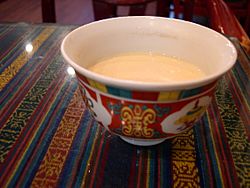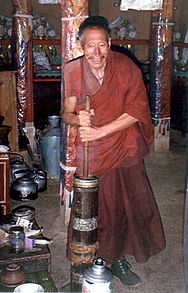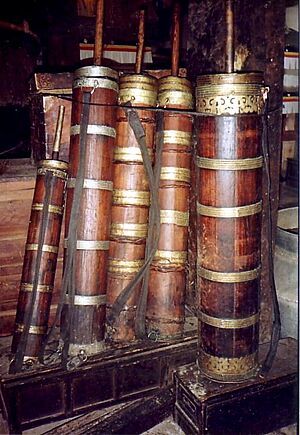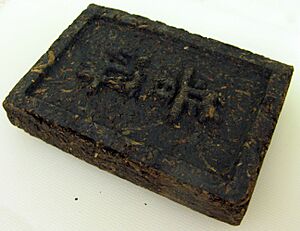Butter tea facts for kids

Butter tea in a bowl
|
|
| Alternative names | Boe cha, cha süma, goor goor cha, cha suskan |
|---|---|
| Type | Beverage |
| Place of origin | Indian subcontinent and Tibet |
| Region or state | South and East Asia and the Caribbean |
| Main ingredients | Tea leaves, yak butter, salt |
Butter tea, also known as po cha (Tibetan: བོད་ཇ་, Wylie: bod ja, "Tibetan tea"), is a special drink. People in the Himalayas and nearby areas enjoy it. This includes places like Nepal, Bhutan, India, Pakistan, Tibet, and parts of China. You can even find it in the Caribbean!
Traditionally, butter tea is made from tea leaves, yak butter, water, and salt. Sometimes, butter from cow's milk is used instead. This is because it's easier to find and costs less. Many believe butter tea first came from the Himalayan region, between Tibet and India.
Contents
History of Butter Tea
Tea arrived in Tibet a long time ago, around the 7th century. This was during the Tang Dynasty in China. However, butter tea itself became popular much later. It was around the 13th century, during the time of the Phagmodrupa dynasty.
There's a story about how butter tea became a thing. A Chinese princess married a king of Tibet. This marriage helped create important trade routes. These routes brought tea from China to Tibet. Later, people started adding butter to this tea. Butter was, and still is, a very important food in Tibetan cooking.
By the 8th century, drinking tea was common in Tibet. By the 13th century, tea was even used in religious ceremonies. Today, butter tea is still very popular in Tibet. Some people drink up to 60 small cups of it every day!
How to Make Butter Tea
Making the best butter tea starts with Pu'er tea leaves. These leaves are boiled in water for about half a day. This makes the tea a very dark brown color. After boiling, the tea is carefully skimmed. Then, it's poured into a tall cylinder. Fresh yak butter and salt are added. The mixture is then shaken or churned. This process makes the tea thick, like a stew or thick oil. Finally, it's poured into teapots or jars.
Another way to make it is to boil water. Then, add several handfuls of tea leaves. Let them steep until the water turns almost black. Add salt, and a little baking soda if you like. The tea is then strained. It goes into a wooden butter churn. A big piece of butter is added. The mixture is churned until it's just right. Then, it's moved to copper pots to stay warm. If there's no churn, a wooden bowl and fast stirring can work too.
In places like the Ganden Monastery in Lhasa, Tibet, they make huge amounts. They prepare food for about 2,500 monks. They boil water every night. The tea itself uses about sixteen bricks of tea. It also uses hundreds of kilograms of butter! Each step of making the tea has its own special prayer. When the tea is ready, a monk rings a gong. This lets everyone know it's time for tea.
Nowadays, it's not always easy to find yak butter or traditional churns. So, people often use tea bags and regular butter. They might even use a blender to mix it all up.
Butter Tea Customs
Drinking butter tea is a big part of daily life in Tibet. Before starting work, Tibetans usually drink several bowls of it. It's also always offered to guests. Since butter is a main ingredient, butter tea gives a lot of energy. This is very helpful in high places like the Himalayas. The butter can also help stop chapped lips.
Tibetan custom says you should drink butter tea in small sips. After each sip, the host will fill your bowl back to the top. So, your bowl is always full! If you don't want to drink more, just leave the tea untouched. When it's time to leave, you can then drink the whole bowl. This way, you follow the rules and don't upset your host.
Another custom involves celebrating a child's birth. A few days after a baby is born, parents have a party. Friends and family come and bring gifts. These gifts often include yak butter tea.
Tibetan Buddhism is a common religion. Because of these beliefs, the yak butter used in the tea is highly respected. Tibetan monks often drink butter tea twice a day. Sometimes, they enjoy it with paksuma, which is a special rice porridge.
Butter tea is also used with tsampa. Tsampa is a traditional Tibetan food made from roasted barley flour. You can pour butter tea over tsampa or dip the tsampa into it.
The strong tea liquid, made by boiling tea leaves many times, can last for days. This is often used in towns. This tea is then mixed with salt and butter. It's churned strongly in a special tea churn (called a mdong mo). Then, it's served hot. Today, an electric blender is often used instead of a churn.
Butter tea is part of many Tibetan ceremonies. At a Sherpa funeral, the family of the person who passed away offers butter tea to guests. During the Tibetan New Year, called Losar, ceremonies last for three days. Monks start their morning with butter tea and sweet rice before their long prayers.
Butter Tea in Popular Culture
Literature
Butter tea is even in the title of a book of poems! The book is called Sweet Butter Tea: A Book of Poems. It was written by Ten Phun, a Tibetan poet. He was born in Lhasa, Tibet. His book has poems about his childhood. This was his first book of poems published in English. Because of this, his friends in Dharamshala, India, nicknamed him “Sweet Butter Tea.” He lives in Dharamshala now.
See also
 In Spanish: Té con mantequilla para niños
In Spanish: Té con mantequilla para niños






